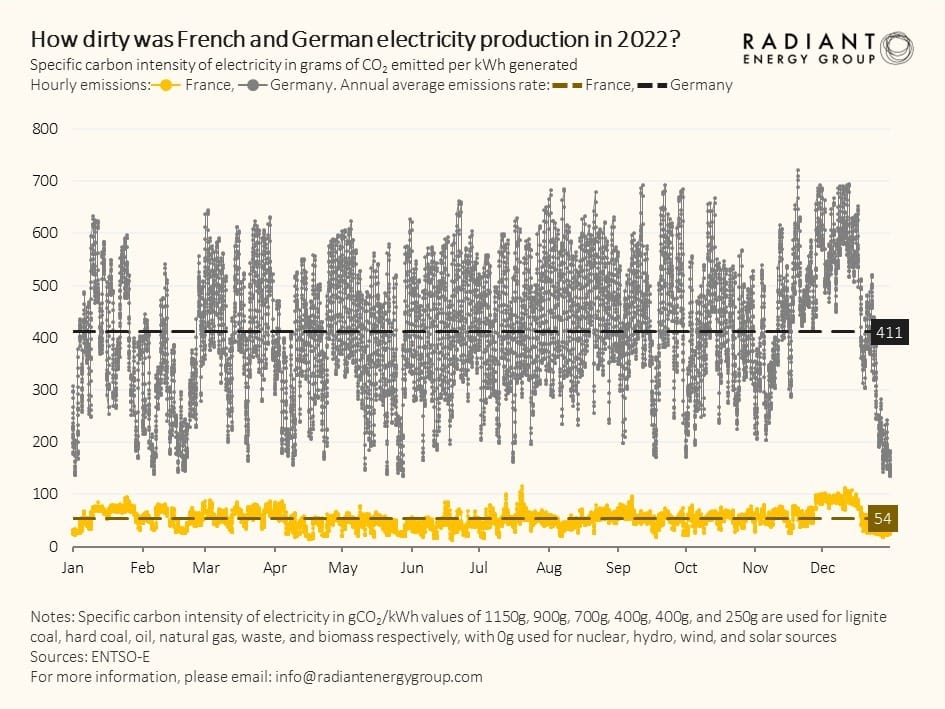Guest Op-Ed: France v. Germany ‘22—Electricity By the Hour
By Mark Nelson
A new analysis from Radiant Energy Group compares France and Germany over every hour of 2022 by a single metric: how much carbon dioxide was emitted per unit of electricity generated in the country. This metric, called “carbon intensity of electricity,” is useful because most people agree it’s not energy itself that’s bad, but rather negative environmental impacts that may be caused by generating that electricity.
France has the most famous dependence on nuclear energy in the world, a result of building 58 reactors in a few dozen years after being caught off-guard by the 1973 oil crisis. France has long enjoyed lower electricity costs than its neighbors and with a fraction of their power sector carbon emissions.
But in 2022, we heard a lot of bad news about France’s failing nuclear fleet. Summer heat waves caused low river levels and high temperatures, which forced plants located in the interior of France to reduce their output. Corrosion issues discovered in late 2021 forced a set of near-identical reactors to shut down for repairs, a cautionary tale of standardization gone wrong. Overall, France's approximately $200 billion nuclear fleet had its worst year of production since being built.
Meanwhile, Germany’s wind and solar energy production hit its highest level ever, covering 33.5% of the country’s electricity needs.
Like what you’re reading? Click the button to get Grid Brief in your inbox!
People often compare Germany to France because of their similar electricity production amount, similar geographical location, and as commonly understood, diametrically-opposed energy policies.
This last point is overstated, as France has endured a decade of antinuclear political leadership, leading to the disastrously low nuclear output of the last two years.
However, as our analysis shows, on average France remains almost an order of magnitude cleaner than Germany on the basis of carbon in electricity. Furthermore, this hourly analysis demonstrates the large range of carbon released by Germany’s power sector due to swings in renewable energy production, itself due to hourly, daily, and seasonal changes in wind and sun availability.

How are these values going to change in 2023? Our view is that Germany is likely to see somewhat worse performance in 2023, and France is likely to show improvement. Why? Germany will produce only a fraction of last year’s 6% total national electricity supply from nuclear energy, as it turns off its final three reactors in April. Germany may end up turning these reactors back on in coming years, but it will take a hit on carbon emissions until it does. On the other hand, France is expected to increase its emissions-free nuclear output as its nuclear fleet recovers from the corrosion-linked shutdowns that have plagued it over the past two years.
Although wind and solar output might increase in Germany in 2023, the country is no longer adding enough wind and solar power plants to ensure this happens, due to the variability of weather and the age-related degradation of wind and solar equipment installed in years past.
What can countries learn from our analysis? Our view is that 2022 was a true stress test of a nuclear powered nation, and a triumph of renewable energy generation. That nuclear-limited France beat renewable-heavy Germany by a factor of eight on carbon suggests that countries without plans to build a nuclear fleet would do well to consider doing so.
Mark Nelson is the founder and managing director of the Radiant Energy Group. He holds an M.Phil in Nuclear Engineering from Cambridge University and has been a consultant to the clean energy industry and environmental organizations around the world. His analytical work has been covered in the New York Times, Wall Street Journal, and leading European papers. You can find him on Twitter.